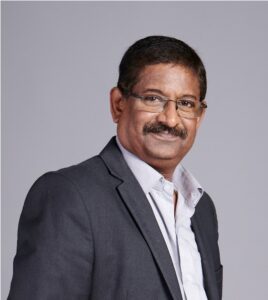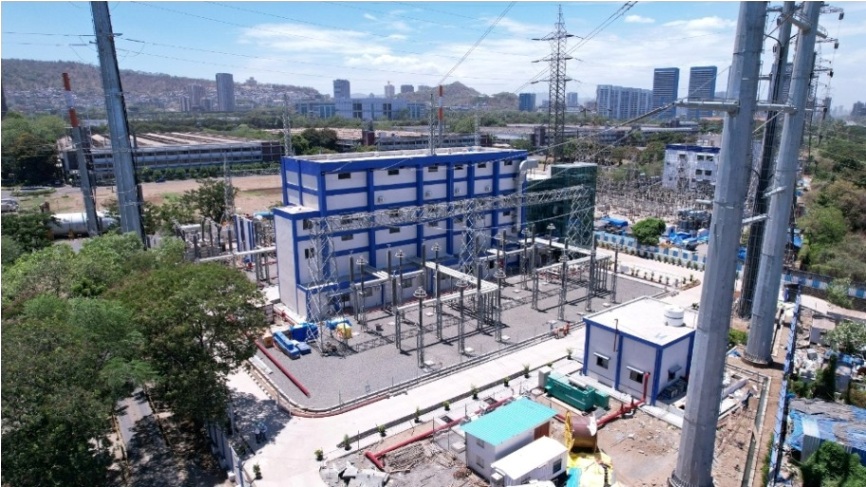Godrej & Boyce recently completed Mumbai’s first 400kV GIS substation. In the backdrop of this historic achievement, T&D India caught up with Raghavendra Mirji, Executive Vice President & Business Head, Godrej Electricals & Electronics, to understand the execution challenges of the landmark Mumbai substation project, as well as to gain technical insights in the GIS substation ecosystem. On his industry outlook, Mirji is confident of tremendous business opportunity in the power transmission infrastructure space, and asserts that Godrej & Boyce would focus on the high-value 400kV and 765kV space. An interaction by Venugopal Pillai.

We note with appreciation that Godrej & Boyce has built its competence in the EHV (400kV) substations domain. What are the current 400kV substation orders on hand?
In fact, we have demonstrated our capabilities to execute orders even up to 765kV projects. While we have executed many critical 400kV GIS and AIS substation projects earlier, the key ongoing projects in 400kV and above segment include: 400kV GIS in Khavda; 400/220kV AIS in Rajasthan; 400kV AIS in Karnataka; 400kV AIS in Telangana; 400kV AIS in Punjab; 765kV AIS in Ahmedabad; 765kV GIS in Khavda, etc.
What are the challenges associated with building of EHV GIS substations as opposed to the conventional AIS ones?
GIS substations, while requiring significantly less space and offering advanced technology compared to AIS substations, are more suitable for urban areas where land is expensive or limited. This is also quite helpful for upgrading the existing low voltage AIS substations.
Besides these benefits, one of the key challenges is the higher initial cost of setting up a GIS substation. It is generally higher than that of an AIS substation due to the complexity of the GIS equipment and the need for specialized installation techniques. There are limited options of OEMs, especially in higher voltage levels and hence, there is a high degree of dependency as well. Testing and commissioning activities of GIS equipment is also complex and requires special skill and competency. The cable termination is quite a critical activity in GIS requiring special skills. Compared to AIS, the civil portion in construction of the GIS substation is quite high and requires special care like PU-coated flooring, dust free environment with either air-conditioned room or with the air controller systems. The biggest challenge is to ensure the entire system is leak proof (SF6 gas).
EHV GIS substations also pose a maintenance challenge. Although they require less maintenance compared to AIS substations, the maintenance required is often more complex and demands specialized equipment and personnel. Consequently, this complexity can result in higher maintenance costs and longer downtime in the event of a fault or failure.
Do you see an increasing shift towards GIS substations?
Yes, despite these challenges, there is a growing trend towards GIS substations, particularly for EHV applications. This shift is mainly fueled by the advantages GIS substations offer, including a smaller footprint, higher reliability, and better environmental performance. With increasing demand for electricity, especially in urban areas, GIS substations are expected to become more prevalent as utilities strive to maximize the use of limited space and enhance the reliability of their power networks. GIS is a key component of the electrical infrastructure in various applications, including power generation, transmission, and distribution.
Commissioning Mumbai’s first 400kV GIS substation has been a landmark development. Please discuss the major contours of the project, highlighting its “vertical” orientation.

The term “vertical orientation” describes the compact design of GIS, enabling a smaller footprint compared to conventional AIS substation. This feature is especially critical in urban areas like Mumbai, where land is scarce and costly. Through vertical construction, GIS substations can utilize less ground space while still accommodating the infrastructure needed for high-voltage electricity transmission.
Key aspects of the project include the high-level engineering in designing the vertical integration of 400kV and 220kV GIS equipment along with control panels in one building, terminating the incoming EHV lines at the specially designed columns of the building thus avoiding the need of additional Gantry towers & the use of cutting-edge GIS technology. This compact design has saved the overall space requirement by per cent.
The GIS substation is designed to cater to 1,500 MVA capacity at 400kV, ensuring a robust and stable power supply for Mumbai’s growing energy needs. Occupying just around 8,800 sqm, this infrastructure breaks new grounds in the compact design for 400kV substations.
“Our dedication to reliability and sustainability is reflected in our achievements in the substation sector.”
What were the major challenges faced and overcome during project execution?
As mentioned, ‘Engineering & Design’ of such complex system was a major challenge. The available space was very less for accommodating the entire scheme. Our Engineering team took this as a challenge and worked on various options. We were successful in designing the compact vertical integration of GIS with higher floor height and extra forces, which addressed the need.
The construction of such a complex design was not easy and we faced many challenges right from excavation, casting of higher height floor, stringing of conductor to GIS building and erection of bushing and cable housing at 12m height.
Since the timelines were also tight, we had to take into account Mumbai’s rainy season that practically restricts outdoor work for almost four months! The good part was that we had a plan in place to address all these challenges. A structured process in engineering helped in releasing required designs in time, and with collaborative efforts with the sub-contractors and suppliers, our site execution team rigorously followed the discipline in driving the progress of the project. We continued working even during the heavy monsoon period by covering the construction site and carried out the internal building work at that time.
Please discuss how this project has enhanced Godrej & Boyce’s competence in the field of GIS substations.
Our dedication to reliability and sustainability is reflected in our achievements in the substation sector, signifying not just business success but also a significant contribution to India’s energy resilience. As we complete the installation of Mumbai’s first 400kV GIS substation adding 1,500 MVA capacity for the city, we are not just constructing substations; we are laying the groundwork for a future where energy is abundant and environmentally friendly. We envision a landscape where advanced technology meets the rising energy demands, creating a brighter and more sustainable tomorrow for India.
This project has showcased Godrej & Boyce’s prowess in managing complex and large-scale infrastructure projects.
Though it could be a bit premature, is there any movement in India with respect to replacing SF6 in gas-insulated switchgear with more environment-friendly options?
Indeed, discussions and initiatives are underway in India regarding the substitution of sulphur hexafluoride (SF6) in gas-insulated switchgear (GIS) with environmentally-friendlier alternatives. SF6 is a potent greenhouse gas with a high global warming potential, prompting increasing concerns about its environmental impact. There have been various SF6 gas alternatives developed and implemented by OEMs which are still in trial phase and may take a few years for commercial production. Most prominent among available options are “Clean air” solutions, which purified air and gas mixtures that both have only a fraction of the adverse climate impact of SF6.
Also, efforts should be made in drafting the standard specifications so that all utilities can incorporate these specifications for their upcoming requirement.
Speaking briefly of Railways, tell us how railway electrification is shaping up following its first order from Indian Railways last year.
Our foray into railway electrification commenced with a substantial project from Indian Railways valued at over Rs.900 crore. This project entails the construction of traction substations and associated works, aligning with India’s vision of modernizing its railways and promoting sustainable transportation. It is a key component of ‘Mission Raftar,’ aimed at enhancing speeds to 160 kmph to 200 kmph on the existing New Delhi-Howrah Route and between Mathura-Palwal on the existing New Delhi-Mumbai routes. The project is under progress as there were changes in the substation land parcels due to addition of third and fourth track.
“Our experience and expertise in these projects have positioned us very well in the market to undertake large-scale 765kV projects.”
Talking about EHV cabling of 220kV and above, some industry observers believe that underground EHV cabling has not picked up in India as expected. What is your view?
The expense of underground extra high voltage (EHV) cabling is notably greater than that of overhead lines, encompassing costs for excavation, installation, and maintenance. Secondly, another hindrance is the ineffectiveness of underground cabling in case of flooding. Pad-mounted transformers used in underground systems get damaged during flooding. It reduces the effectiveness of the whole system. Implementing underground EHV cabling also poses technological challenges, such as ensuring adequate insulation, effectively managing heat dissipation, and dealing with fault detection and repair issues. These technical complexities can escalate the overall intricacy and cost of underground installations.
Returning to substations, do you have plans of moving forward aggressively in the 765kV domain?
Yes, we are currently executing projects ranging from 132kV to 765kV, encompassing both AIS and GIS technologies. We have received some prestigious orders of 765kV that are under execution. Our experience and expertise in these projects have positioned us very well in the market to undertake large-scale 765kV projects. We are fully prepared to be a part of the revolution in the India’s power transmission sector and are excited about the possibilities in the 765kV domain.
“Our focus will be on high value 400kV and 765kV segments.”
It has been estimated that power transmission infrastructure (of 220kV and above) will need investment of over Rs.4 trillion between FY23 and FY27. How do you see emerging business opportunities for Godrej & Boyce in the substation space?
Dedicated transmission corridors for RE will further drive investment in the power transmission sector. The investment in power transmission infrastructure presents opportunities for us to further expand our presence in the market. With the commissioning of large-scale substations, Godrej & Boyce has demonstrated its commitment to providing reliable, affordable, and sustainable energy across various regions.
These substations are not only being built in metro cities but also in the extreme terrains of the northeastern states, Jammu, and the RE hub in Khavda, Gujarat. We have plans for the next three years to scale up the substation business, targeting growth of around 25 per cent year-on-year. We have already established credentials with most of Central and state utilities and since last two years, we are also expanding our business to the private sector.
Our focus will be on high value 400kV and 765kV segments. Apart from the power sector, we are driving growth in railways and solar projects as well.
(Note: Godrej Electricals & Electronics is part of Godrej & Boyce. Photographs used in this interview relate to substation projects of Godrej & Boyce.)
